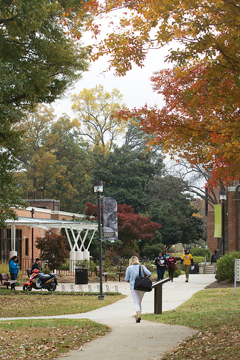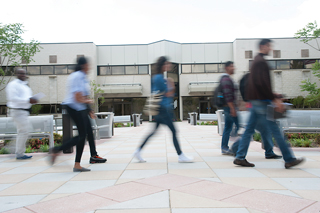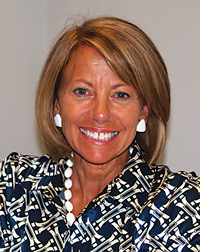Alex Ritchie had it all planned out. After graduating from Clover Hill High School in 2013, she would spend the next four years at Ferrum College in Southwestern Virginia studying engineering.
But her finances said otherwise.
“My parents were going through a divorce, and that put a financial strain on things,” she said. “I was not very happy at all. I had no other choice but to go to community college. It’s not what I wanted, but it’s what I could afford.”
As her friends headed off to 4-year universities, Alex enrolled at John Tyler Community College.
“I didn’t want to go that route at all,” she said. “I definitely had the mindset that some people have that community colleges are looked down upon. I felt incompetent.”
 How quickly her opinion changed.
How quickly her opinion changed.
“I realized how wrong I was,” she said. “All my teachers were great. They were invested in me and in my future. This was the best thing I’ve done so far in my life.”
Alex received her associate’s degree in engineering in May and transferred to Virginia Commonwealth University where she is studying biomedical engineering. She plans on graduating in 2017.
At VCU, her tuition is more than double what she was paying at John Tyler. Lower costs are just one of the advantages of community colleges.
“The smartest and savviest families are making the decision to start off college with their community college,” said Jeffrey Kraus, an assistant vice chairman for Virginia’s Community College System (VCCS). “You can knock out the first two years of college and buy your son or daughter a car and still come out ahead.”
 According to VCCS, the average tuition cost per year to attend a 4-year public college in Virginia is about $11,000. The cost to attend a community college is about $4,000.
According to VCCS, the average tuition cost per year to attend a 4-year public college in Virginia is about $11,000. The cost to attend a community college is about $4,000.
“I saved more than $20,000 by going to community college first,” said Matthew Vinson, who received an associate’s degree in science and engineering from Reynolds Community College in 2008. He transferred to the University of Virginia and graduated in 2010 with a degree in civil engineering. “I have friends who are $40,000 in debt right now. I’m so happy I did what I did – for many reasons.”
Vinson, a project engineer at Dominion, was homeschooled. By going to community college first, he said, he was able to gain confidence before going off to a large university.
“I liked starting out in my hometown,” he said. “I felt more comfortable. I felt so prepared. A 4-year school is not for everyone.”
 Virginia’s General Assembly established the Virginia Community College System in 1966 to address Virginia’s unmet needs in higher education and workforce training. Today, there are twenty-three community colleges on forty campuses across the Commonwealth. John Tyler and Reynolds serve the Richmond area through a combined five campuses.
Virginia’s General Assembly established the Virginia Community College System in 1966 to address Virginia’s unmet needs in higher education and workforce training. Today, there are twenty-three community colleges on forty campuses across the Commonwealth. John Tyler and Reynolds serve the Richmond area through a combined five campuses.
“A lot of people who went to college and now have children entering college think it’s the same universe,” Kraus said. “It is not. People are not necessarily pursuing higher education in traditional ways because of the rising costs or because of [the desire for] lifelong learning.”
Just more than half (56 percent) of community college graduates are in transfer programs and are planning to pursue a bachelor’s degree. The rest are there for “lifelong learning.” None have the same story.
Some are there because the job they held for twenty-five years is becoming more technical and they need to learn new skills. Others are enrolled in a specialized certificate program that will land them a job quickly in auto mechanics, welding, the culinary arts, drafting, and other fields. Still others were laid off from their jobs and are enrolled to pick up marketable skills. They choose community college because of lower costs, flexible class schedules, and the close proximity to home.
“I was young and dumb when I decided college wasn’t for me,” said Jeremy Wilkinson, a 35-year-old operations manager at Chesterfield County Airport. “But now I realize to advance in my job, I really need to return to school.”
After graduating from L.C. Byrd High School in 1999, Wilkinson took a job as an airfield technician. He now is taking two night classes a semester at Tyler to learn about electrical engineering.
“I have really found my groove here,” he said. “I hope this will give me the skills I need to take me to the next level. I think college has really become a necessity today.”
Maurice A. Jones, secretary of commerce and trade, wrote in a column that in less than a decade, Virginia will need to replace more than 930,000 retiring workers and fill another 500,000 new jobs. About 50 to 65 percent of those opportunities will be specialized, skilled, and technical jobs – jobs that require competencies usually acquired through post-secondary education. And the VCCS estimates that by 2018, two out of every three jobs will demand more than a high school diploma.
With tuition rates rising across the country at 4-year institutions and with specialized, technical skills in higher demand, community colleges are becoming more popular. Between 2008 and 2012, Virginia community colleges picked up 50,000 students, a historic increase according to the VCSS. The main reason for that, Kraus said, was the recession. As workers were laid off, they returned to school for training.
Today, 273,026 students earn community college credits every year.
“One of the big differences between us and 4-year colleges is that universities largely define themselves by who they keep out,” Kraus said. “We do things differently here. We define ourselves by who we let in – everyone who needs us.”
Virginia’s community colleges have an open enrollment policy. And through system-wide agreements, students who graduate from one of Virginia’s community colleges with an associate’s degree and a minimum grade point average may obtain guaranteed admission to more than twenty of the Commonwealth’s colleges and universities. Community colleges and universities work closely together to make sure credits transfer smoothly from one program to the next.
“I’m not sure where I’d be without community college,” said Abigail Rose, a part-time student and full-time nurse at Sheltering Arms. “I wanted to stay close to home and I wanted an affordable option. I wanted to be able to work and go to school. This has worked out perfectly for me.”
Rose, who lives in Mechanicsville, earned an associate’s degree in nursing from Reynolds in 2013 and now is working on her bachelor’s degree in nursing at the University of Virginia.
“I wasn’t sure nursing was for me, so I didn’t want to get thrown into a 4-year program right off the bat,” she said. “The smaller classes were not so overwhelming. I felt like a person, not just a number. The professor gets to know you and you feel part of something special. It was a great experience.”
Students at community colleges are teenagers, working parents, and senior citizens. They are just starting to realize their dreams, or they are polishing their careers. They come part time, full time, in person, online, during the day, and at night.
“For the most part, if you knock on our front door, we let you in,” said Dr. Genene D. LeRosen, executive vice president at Reynolds. “All our community colleges today really try to meet the needs of anyone who walks through our doors. Since this is our community, we are focused on our students…and giving them the best education possible.”
When Victor Aguirre considered his future, he knew that community college would be his stepping stone to a four-year degree.
“I really wanted to help out my parents both financially and physically,” he said.
After graduating from Douglas Freeman High School in 2013, Aguirre decided to attend Reynolds so he could stay home and help his father with his landscape business. The thousands he is saving in tuition will also go a long way in helping support his younger sister when she enters college in a few years.
“I think sometimes teenagers are so eager to get away from home to the excitement of a 4-year school that they don’t think about the financial aspects of it,” said Aguirre, who transferred to James Madison University this semester to study business. “I feel very fortunate and proud to experience both community college and a 4-year school.”
Because of the diverse student population at community colleges, recent high school graduates often find themselves sitting in class next to a seasoned business professional back in the classroom to brush up on his or her skills.
“You have older students in the classroom with you who can share their life experiences and their real-work experiences,” Vinson said. “They bring a lot to the classroom. We learned a lot from each other. It was great.”
As workplace demands continue to evolve, community colleges will no doubt remain a vital part of the communities they serve.
“I think community colleges have always been meeting the needs of industry and the community, but the value of the community college is coming out more today,” said Dr. William Fiege, vice president of learning and student success at John Tyler. “Students see the value. We have something for everyone here.
“Students today have so many different goals. Our job is to meet those goals that will help them sustain their careers and support their families. Nothing is more exciting than helping students live their dream.”
Without community college, Wilkinson, the 35-year-old engineering student, would not be living his dream.
“If there was no such thing as community college, I probably never would have gone back to school,” he said. “It would have limited my ability to pursue this goal of mine. But now, I’m gaining so much confidence. I so appreciate this opportunity because I know it will provide a brighter future for my family.”
John Tyler Community College

804-796-4000 or jtcc.edu
• Opened in 1967
• Campuses in Chester and Midlothian, plus a Nursing Education Center in Chesterfield and workforce training offices at the Featherstone Professional Center
• John Tyler is the fifth largest college in the Virginia Community College system.
• Enrollment: 13,753 students for the 2014-15 school year
• 35 percent in college transfer degree programs
• 27 percent are enrolled in degree, certificate, or career studies certificate programs that are designed to prepare students for immediate entry into the workforce
• 85 percent are part-time students
Reynolds Community College

804-371-3000 or reynolds.edu
• Opened in 1972
• Campuses on Parham Road, downtown, and in Goochland County
• Reynolds is the third largest college in the Virginia Community College system.
• Enrollment: 17,742 students for 2014-15 school year
• 45.5 percent in college transfer degree programs
• 38.6 percent are enrolled in degree, certificate, or career studies certificate programs that are designed to prepare students for immediate entry into the workforce
• 84.7 percent are part-time students
Virginia’s Community
Colleges by the Numbers
Virginia’s General Assembly established the Virginia Community College System in 1966 to address Virginia’s unmet needs in higher education and workforce training. Today, there are twenty colleges on forty campuses across the Commonwealth.
Students:
• 273,026 earn community college credits every year
• 78,782 served through workforce training and continuing education courses
• 34,082 high school students receive career coaching
• 34,384 high school students earn college credit through dual enrollment
Degrees:
• 31,000 degrees, diplomas, and certificates earned last year
Workforce:
• 13,199 employers served through workforce programs at Virginia’s Community Colleges
Tuition comparison:
• 4-year public college: $10,931
• Community college: $4,080
For more information on Virginia’s Community College system, call 804-819-4901 or go to vccs.edu.
Knocking Out College Credits
While in High School
Sierra Semel jump-started her college career while still a student at J.R. Tucker High School in Henrico County.
The 18-year-old earned an associate’s degree in social sciences from Reynolds Community College before ever walking down the aisle to receive her high school diploma in June.
“This was a wonderful opportunity for me and allowed me to get ahead,” she said. “It feels pretty good.”
She entered Virginia Commonwealth University in the fall and is studying engineering. She credits the community college system with giving her the foundation she needs to succeed.
“I’m more prepared than I ever thought I could be,” she said. “I never thought community college would be something that would pertain to me. I always thought I’d go straight from high school to a 4-year school. But this was such a great opportunity.”
That opportunity arose out of legislation passed in Virginia in 2012 mandating that an agreement be set up between the Virginia Community College System and the high schools that surround each community college. Reynolds established its Advance College Academy soon after, and Sierra was part of the first graduating class last spring.
Students typically apply to the ACA in the eighth grade through their local school division, enroll in advanced high school courses in the ninth and tenth grades, and take the required college coursework for the associate’s degree during the eleventh and twelfth grades. Students in the ACA program are required to attend a 5-week session of college courses during the summer between their sophomore and junior year.
The program carries a fee that varies depending on the school division.
“We are building their confidence before they set off for a 4-year school,” said Dr. Genene D. LeRosen, executive vice president at Reynolds. “This really gives high school students the chance to get to know themselves better.”
John Tyler has a similar program called Upgrade. Both programs provide enrollment pathways for high school students to earn an associate’s degree (sixty college credits) while completing the requirements for their high school diploma.
“Not only does this knock some credits out of the way, but it has helped our daughter get such a well-rounded education,” said Sierra’s mother, Cathy Semel. “These kids are really challenged in this program.”
High school students have other options for gaining college credit without committing to an associate’s degree. They may take dual enrollment courses taught at their high school, advanced placement (AP) classes and the subsequent tests, or they may attend classes on a community college campus.
“It was awesome to get ahead,” said Julie Hennessy, who took several classes at John Tyler while a senior at Clover Hill High School. “I knew this was a much better use of my time.”
After high school graduation, she enrolled full time at Tyler and received her associate’s degree in arts and science. She has since graduated from VCU with a degree in history and religious studies and now owns four UPS stores with her husband.
“I’m so glad I made that decision to enroll in community college,” she said. “To be able to get a head start on college while you are still in high school is just incredible. It’s an opportunity no one should pass up.”
It can be a bit intimidating, however, for a 15- or 16-year-old to tackle college-level courses.
“We were treated like college students,” Sierra Semel said. “We were treated like adults. It can be a little scary, but it really helped me grow up. College can be a culture shock. Now I’m better prepared.”
Knocking out college credits while in high school can also save families thousands of dollars.
“It really is such an affordable option,” Hennessy said. “It may not be for everyone, but it was an incredible experience for me. I wouldn’t change a thing.“




